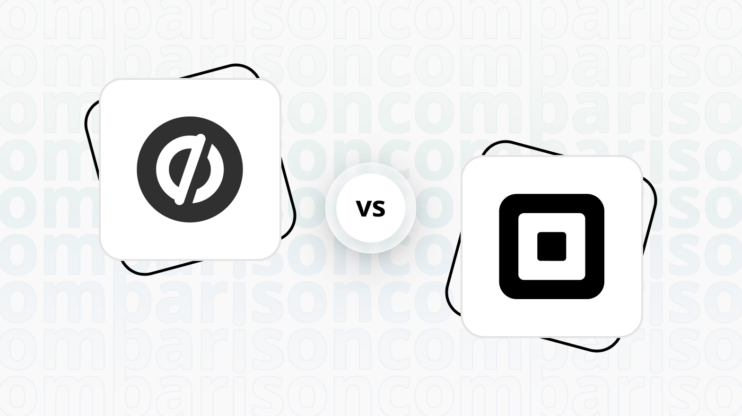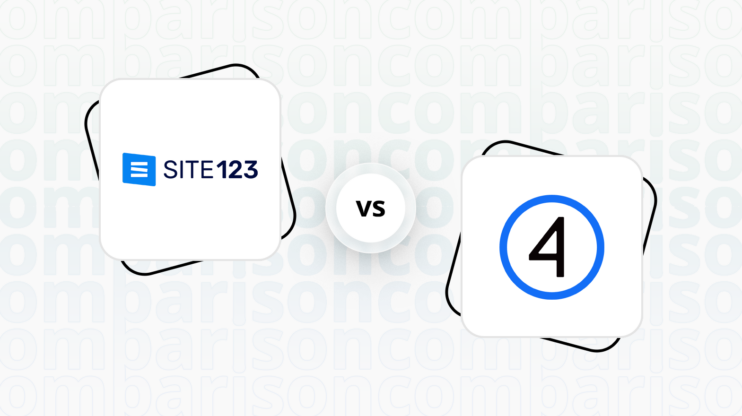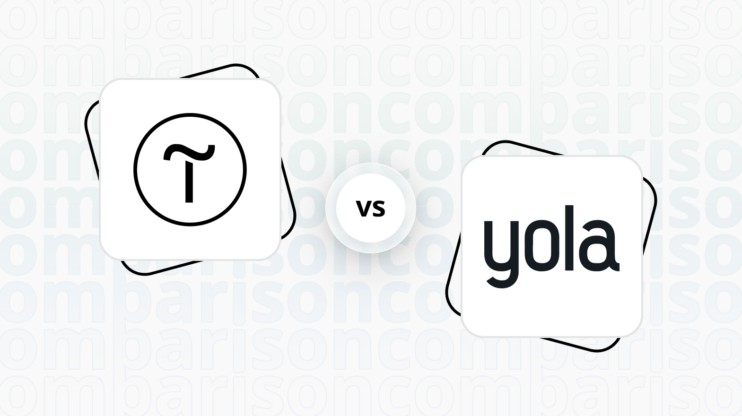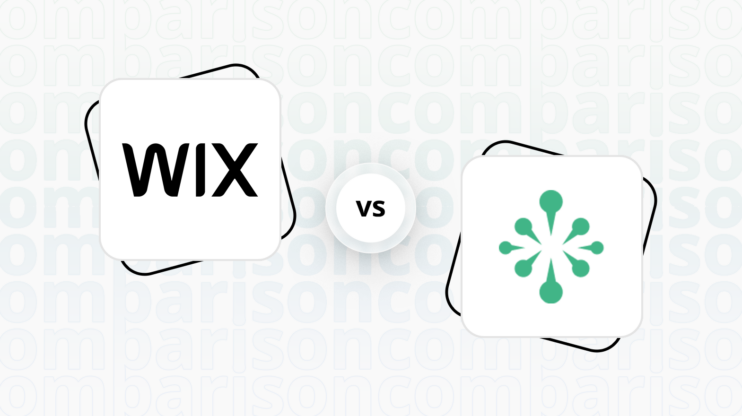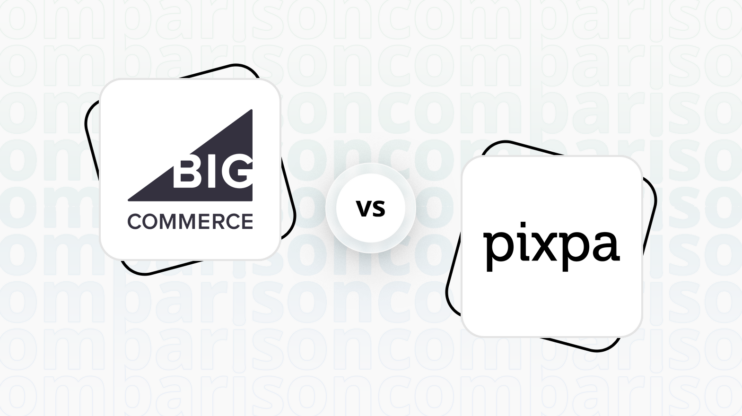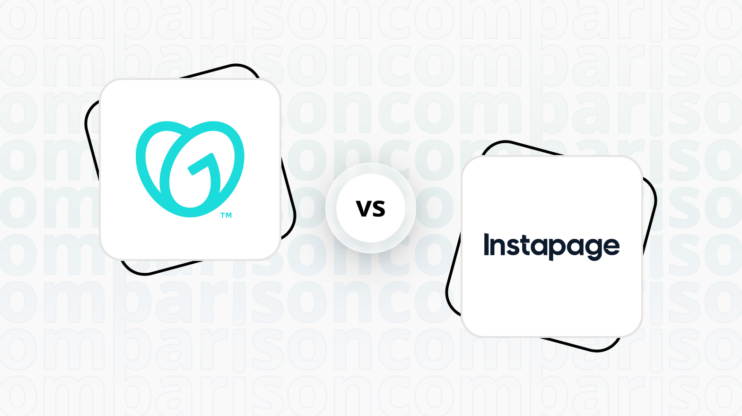Final verdict
Unbounce and Webnode both offer unique strengths, catering to different user needs and preferences.
-
Unbounce (Overall Grade: 6.4/10)
is a powerful tool for creating high-converting landing pages, popups, and sticky bars. It excels in conversion rate optimization and offers a wide range of templates and integrations with marketing tools. Unbounce is ideal for marketers and businesses focused on lead generation and campaign performance. However, it lacks native ecommerce features and has a steeper learning curve for beginners. -
Webnode (Overall Grade: 6.5/10)
is a user-friendly website builder suitable for beginners and small businesses. It offers a drag-and-drop interface, a variety of templates, and basic ecommerce capabilities. Webnode is perfect for users looking to create simple websites quickly and easily. While it may not have the advanced features of Unbounce, it provides a solid foundation for building and managing websites without any coding knowledge.

|

|
|
|---|---|---|
|
Design functionalities & templates |
7.8 |
7.1 |
|
Ease of use |
8.2 |
8.0 |
|
Ecommerce |
4.8 |
6.3 |
|
Website Editors |
7.5 |
7.3 |
|
Product testing options |
6.6 |
5.3 |
|
Price |
7.0 |
7.7 |
|
Hosting quality |
3.9 |
6.3 |
|
Website speed optimization |
5.6 |
6.1 |
|
Plugins and integrations |
6.8 |
6.8 |
|
Marketing features |
7.4 |
5.5 |
|
Customer support |
7.7 |
5.3 |
|
Security |
8.4 |
7.7 |
|
AI capabilities |
7.5 |
5.3 |
|
User Management |
7.2 |
6.9 |
| Overall |
6.4 |
6.5 |
Best for ecommerce
 4.8
4.8
 6.3
6.3
Verdict
: Unbounce and Webnode cater to different ecommerce needs. Unbounce excels in creating high-converting landing pages, while Webnode offers a more traditional ecommerce experience with built-in store management tools.
-
Unbounce
: Unbounce is tailored for creating targeted landing pages that integrate with ecommerce platforms like Shopify and Ecwid. It focuses on optimizing conversion rates rather than providing native ecommerce features. This makes it ideal for businesses looking to drive traffic to specific products or promotions. However, its lack of built-in ecommerce functionalities might be a limitation for those needing a comprehensive online store solution. -
Webnode
: Webnode provides a more conventional ecommerce setup with an online store builder, product management tools, and various payment options. It offers ecommerce-specific templates and extensive customization for product pages, making it suitable for beginners who want to set up a simple online store quickly. While it may not have the advanced marketing integrations of Unbounce, it covers the essential ecommerce needs effectively.
Best for informational & business websites
 5.9
5.9
 7.2
7.2
Verdict
: When it comes to creating informational and business websites, Webnode outshines Unbounce with its higher score and user-friendly features. Unbounce, while powerful for landing pages, may not be the best fit for general informational sites.
-
Unbounce
: Unbounce is tailored for creating high-converting landing pages, popups, and sticky bars. Its focus on conversion rate optimization makes it a strong choice for marketers, but it may be overkill for simple informational websites. With a score of 5.9, it offers advanced features and integrations but lacks the simplicity needed for straightforward business sites. -
Webnode
: Webnode is a versatile website builder that excels in creating simple, user-friendly informational websites. Scoring 7.2, it offers a drag-and-drop interface and a variety of customizable templates, making it ideal for beginners and small businesses. Webnode’s ease of use and flexibility make it a better choice for those looking to quickly set up an informational site without the need for advanced features.
Detailed comparison
Design functionalities & templates
Design FunctionalitiesRepresents how well each platform allows for creative design and customization of websites.Score Components:
- Template Variety (30%): Range and quality of design templates.
- Customization (30%): Flexibility and options for design alterations.
- User Interface (20%): Ease and intuitiveness of the design process.
- Responsiveness (10%): Adaptability to different devices and screen sizes.
- Innovation (10%): Unique design features and tools.
 7.8
7.8
 7.1
7.1
🏆
Winner: Unbounce.
If you’re looking for a platform that offers more advanced features and integrations for creating optimized landing pages, Unbounce is the preferred choice.
Unbounce provides a gallery of over 100 high-converting templates for landing pages, popups, and sticky bars. These templates are designed with conversion in mind, incorporating knowledge and insights gained from Unbounce’s experience in optimizing landing pages. Users have the flexibility to choose from these ready-to-use templates or start with a blank canvas to create their own designs using Unbounce’s drag-and-drop builder.
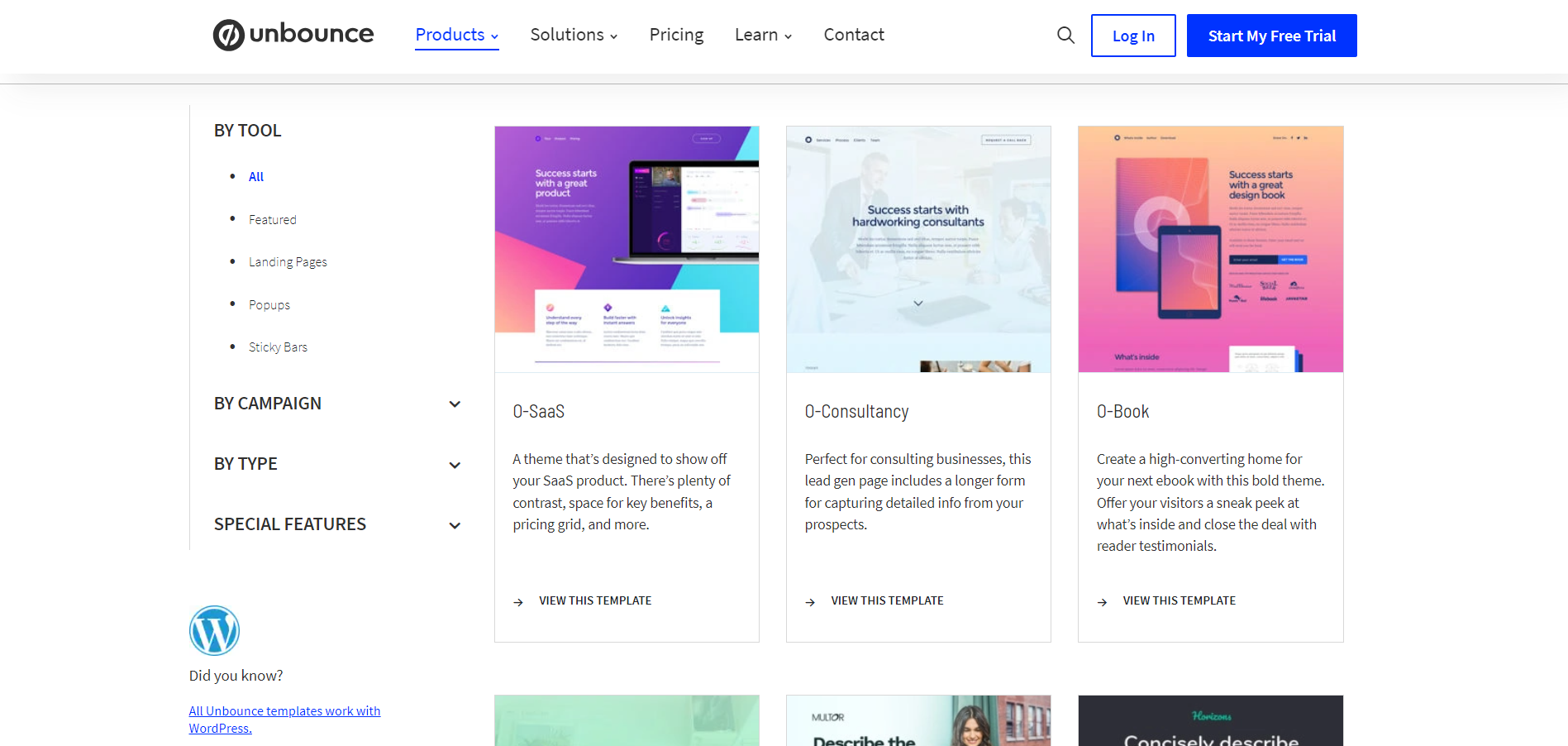
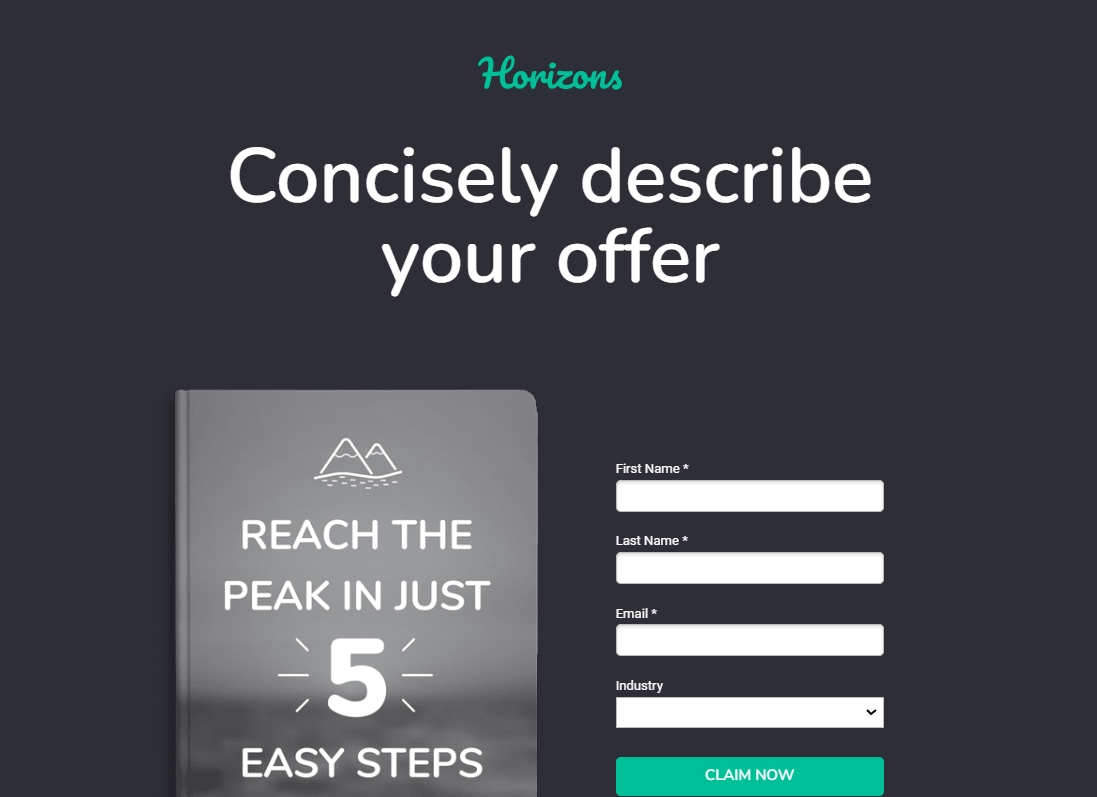
Compared to Unbounce, Webnode offers a variety of website templates designed for different purposes, from business and portfolios to restaurants and travel. These templates are customizable and responsive, ensuring they display well on any device. While an exact number isn’t available, Webnode provides a wide selection to cater to diverse website needs.
Get a head start on website creation with AI
Create a custom website tailored to your business needs 10X faster with 10Web AI Website Builder!
Ease of use
Ease of useReflects the platform’s overall user-friendliness.Score
Components:
- Learning curve (40%): Quickness and ease of getting started.
- Interface design (30%): Simplicity and intuitiveness of layout.
- User guidance (20%): Quality of tutorials and support.
- Flexibility (10%): Adaptability to various user skills.
 8.2
8.2
 8.0
8.0
🏆 Winner: Unbounce
. Scoring 8.2, Unbounce is slightly ahead of Webnode, which scored 8.0. Unbounce’s user-friendly interface and wide selection of templates make it easy for users to design and customize landing pages. Webnode, on the other hand, is praised for its straightforward interface and drag-and-drop functionality, making it suitable for beginners.
Learning Resources
🏆 Winner: Unbounce
. Unbounce offers a rich collection of learning resources, including a comprehensive Help Centre, the Unprompted Podcast for marketing insights, and a Video Library for visual learning. Webnode also offers a variety of learning resources, but Unbounce’s resources are more comprehensive and tailored to help users maximize their platform’s capabilities.
For ecommerce
EcommerceMeasures the platform’s effectiveness in supporting online business activities.Score Components:
- Ecommerce themes and templates (20%): Variety and design of templates.
- Product management (25%): Ease of managing and organizing products.
- Payment options (25%): Variety and convenience of payment methods.
- Ecommerce features (20%): Features for managing an ecommerce store.
- Integration (10%): Compatibility with external e-commerce tools and services.
 4.8
4.8
 6.3
6.3
Unbounce and Webnode offer different approaches to ecommerce. Unbounce focuses on creating highly targeted landing pages for ecommerce, aiming to double conversion rates. It integrates with ecommerce platforms like Shopify and Ecwid, but does not offer native ecommerce features. Webnode, on the other hand, provides a more traditional ecommerce offering with an online store builder, product management tools, and various payment options.

|

|
|
|---|---|---|
|
Ecommerce themes and templates |
2.0 |
6.5 |
|
Product page customization |
3.0 |
7.0 |
|
Payment processing and commissions |
6.5 |
6.8 |
|
POS capabilities |
0.0 |
4.0 |
|
Payment gateways |
7.0 |
7.0 |
|
Product numbers |
0.0 |
5.5 |
|
Additional ecommerce features |
4.5 |
6.0 |
Unbounce ecommerce features:
- Shopify, Ecwid, or and other ecommerce solutions integration
Webnode ecommerce features:
- Shipping options
- Payment gateway integrations
- Order management
- Coupons and discounts
Ecommerce themes & templates
Unbounce primarily focuses on building landing pages, and does not have ecommerce specific templates. On the other hand, Webnode offers ecommerce-specific templates designed for creating online stores. These templates typically come with features such as product showcasing, shopping cart functionality, support for various payment gateways, and customization options.
Product page customization
Unbounce does not offer the ability to create or customize product pages, as it’s primarily focused on building landing pages. However, it does offer the possibility to integrate with ecommerce platforms such as Shopify or Ecwid. Webnode provides users with extensive customization options for product pages, allowing for the creation of visually appealing and informative displays.
Payment processing
Unbounce supports payment processing through an integration with Stripe, allowing users to create landing pages that can handle transactions directly. Webnode supports various payment gateways, including popular options like PayPal and Stripe, for online transactions. While Webnode itself doesn’t charge commissions on transactions, payment gateways may have their own fee structures.
Website Editors
Website EditorsEvaluates the platforms’ website building and editing capabilities.Score Components:
- Customization tools (40%): Range and power of editing features.
- Editor usability (30%): User experience within the editor.
- Design flexibility (20%): Freedom in layout and design changes.
- Update and maintenance ease (10%): Simplicity of updating and maintaining the site.
 7.5
7.5
 7.3
7.3
🏆
Winner: Unbounce
. Unbounce, with a score of 7.5, is a powerful, user-friendly website builder specifically designed for creating custom landing pages, popups, and sticky bars. It provides a wide range of templates and a drag-and-drop interface, making it easy to create and test different layouts and elements to see what works best for your audience. Additionally, it integrates with numerous marketing tools and analytics platforms, enabling marketers to capture leads, launch campaigns, and analyze performance data all in one place.
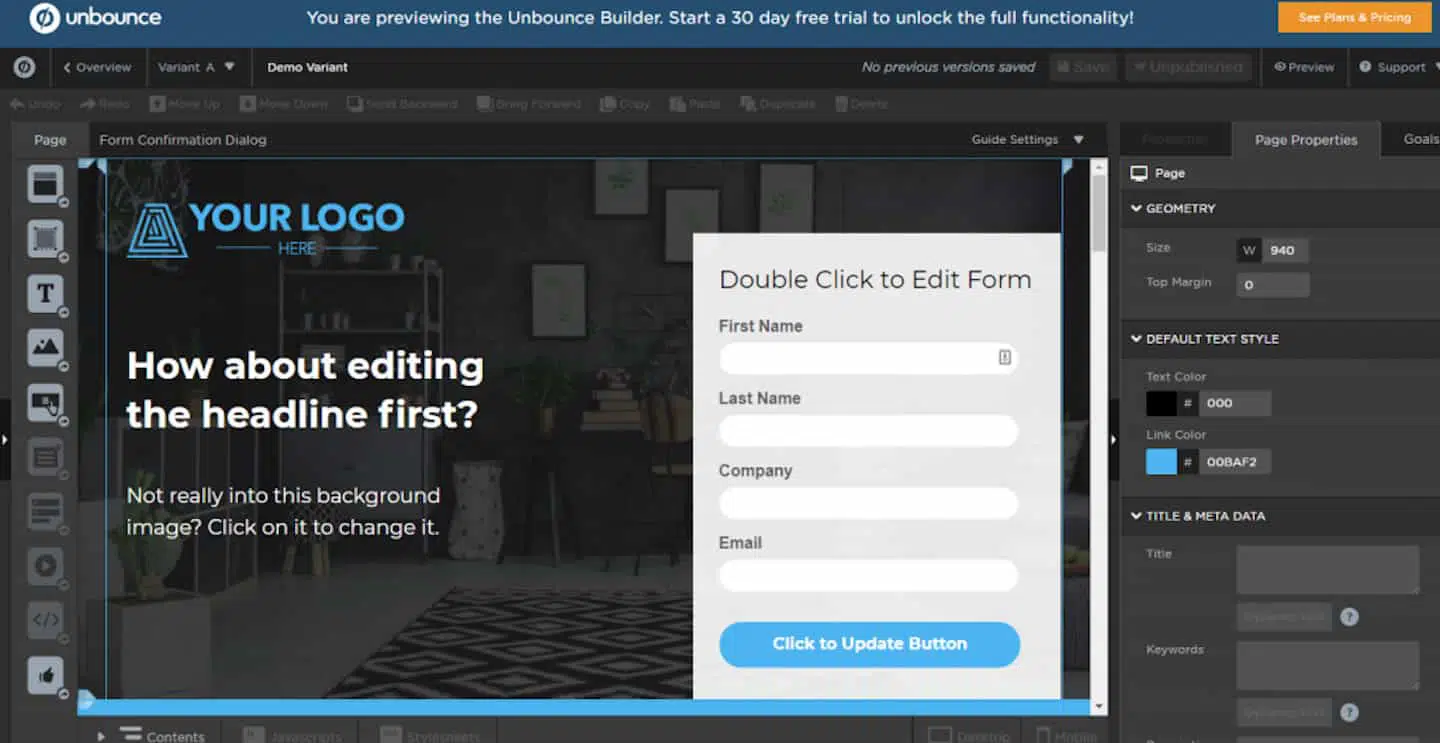
Webnode, scoring 7.3, is a website builder that allows you to create a website without needing any coding knowledge. It uses a drag-and-drop interface, which means you can simply move elements around the page to create your desired layout. Webnode offers free plans, but these have limitations on storage and features. Paid plans offer more storage, custom domain names, and the ability to remove Webnode ads from your website. Overall, Webnode is a good option for beginners who want to create a simple website quickly and easily.
Mobile editor/app
 0
0
 5.5
5.5

🏆
Winner: Webnode
. Neither Unbounce nor Webnode offers a dedicated mobile editor app. However, Webnode allows users to edit their website using the mobile browser version of the editor, although it comes with certain limitations. This feature provides some level of flexibility for on-the-go adjustments, which can be beneficial for users needing to make quick changes without access to a desktop.
Unbounce, on the other hand, does not provide any mobile editing capabilities, which can be a significant drawback for users who require mobile access to their website builder.
In summary, Webnode receives a higher rating due to its ability to offer some mobile editing functionality through a mobile browser, whereas Unbounce lacks this feature entirely.
Product testing options
Product Testing OptionsAssesses the options for trying out platform features before commitment.Score Components:
- Trial quality (40%): Extent and usefulness of the trial or free version.
- Feature accessibility (30%): How many features are available to test.
- Trial duration (20%): Length of the trial period.
- Ease of transition (10%): Smoothness of moving from trial to paid plans.
 6.6
6.6
 5.3
5.3
Overall Result
:
Unbounce wins
. Unbounce scores 6.6 in product testing options, while Webnode scores 5.3. Unbounce offers a 14-day free trial during which users can test all premium features, but requires billing information for the trial. Webnode, on the other hand, offers a free plan with limited features and no trial version. However, it does provide a 15-day money-back guarantee.

|

|
|
|---|---|---|
|
Free Plan |
No |
Yes |
|
Trial Duration |
14 days | No trial version |
|
Testing Premium Features |
Yes, during free trial |
Limited, with free plan |
|
Money Back Guarantee |
No |
15-day money back guarantee |
Price
PriceLooks at the cost-effectiveness and value for money of each platform.Score Components:
- Plan value (40%): What each pricing tier offers.
- Transparency and clarity (30%): Clearness of pricing structures.
- Flexibility of plans (20%): Range of options to suit different budgets.
- Hidden costs (10%): Additional expenses not included in the plan.
 7.0
7.0
 7.7
7.7
Unbounce offers more advanced features and a significant discount on annual billing, while Webnode has a lower starting price and a range of plans to suit different needs.

|

|
|
|---|---|---|
|
$0-$10 |
No offering at this amount. |
LIMITED ($5.50/month): Basic plan, 200 MB storage, attach domain, website statistics, up to 5 form fields, last 30 days backup. This plan allows to manage 1 website with unlimited number of pages. Value for Price: 3.0 |
|
$10-$20 |
No offering at this amount. |
MINI ($10.00/month): All essentials for a simple website, 1 GB storage, 3 GB bandwidth, website statistics, 1 email account. This plan allows to manage 1 website with unlimited number of pages. Value for Price: 4.5 |
|
$20-$30 |
No offering at this amount. |
STANDARD ($16.90/month): For starting an online store, 3 GB storage, 10 GB bandwidth, 20 email accounts, basic store features. This plan allows to manage 1 website with unlimited number of pages. Value for Price: 6.0 |
|
$30-$40 |
No offering at this amount. |
PROFI ($26.50/month): Professional websites, 7 GB storage, unlimited bandwidth, 100 email accounts, full online store capabilities. This plan allows to manage 1 website with unlimited number of pages. Value for Price: 7.5 |
|
$90-$100 |
No offering at this amount. |
BUSINESS ($34.90/month): Comprehensive e-commerce, 15 GB storage, unlimited bandwidth, 1000 email accounts, advanced online store features. This plan allows to manage 1 website with unlimited number of pages. Value for Price: 8.5 |
|
$100-$200 |
Build ($99.00/month): Provides tools for building and launching high-converting landing pages, unlimited pages, popups, sticky bars, a form builder, free hosting, AI copywriting, custom scripts, 1,000+ integrations, support for 1 root domain with unlimited subdomains, catering up to 20,000 monthly unique visitors. Value for Price: 6.5 |
No offering at this amount. |
|
$200-$300 |
Experiment ($149.00/month): Includes everything in the Build plan plus unlimited A/B tests, advanced reporting, dynamic text replacement, support for 2 root domains, and up to 30,000 monthly unique visitors. Value for Price: 7.5 |
No offering at this amount. |
|
$600+ |
Optimize ($249.00/month): Adds to the Experiment plan with AI traffic optimization, visitor behavior insights, advanced targeting, supports 3 root domains, and caters to up to 50,000 monthly unique visitors. Value for Price: 8.0 |
No offering at this amount. |
location. As a result in rare cases the prices displayed here can differ from the ones you see on their
websites.
Hosting quality
Hosting
qualityExamines the reliability and performance of the hosting solutions.Score Components:
- Uptime (40%): Consistency and reliability of website availability.
- Speed (30%): Loading times and performance.
- Bandwidth and storage (20%): Sufficiency of resources provided.
- Data centers (10%): Quality and distribution of hosting infrastructure.
 3.9
3.9
 6.3
6.3
🏆
Winner: Webnode
Both Unbounce and Webnode offer hosting services, but neither provides specific details about the type of hosting or the locations of their data centers. However, Webnode has a slightly higher uptime and offers automated backups on higher plans, which gives it an edge over Unbounce.

|

|
|
|---|---|---|
|
Do they offer hosting? |
Yes |
Yes |
|
Type of hosting: |
Not specified |
Not specified |
|
Uptime: |
99.96% |
99.6% |
|
Uptime Guarantee: |
No |
No |
|
Data Centers: |
Not disclosed |
Not disclosed |
Website Speed Optimization
Website Speed OptimizationEvaluates optimization of website loading timesScore Components:
- PageSpeed Score (30%): Google’s score indicating performance optimization.
- Loading Time (30%): The average time until a website is fully interactive.
- Mobile Optimization (15%): Optimization effectiveness for mobile devices.
- Resource Optimization (15%): Optimizing images, scripts, and other heavy resources.
- CDN Usage (10%): Use of CDN to enhance speed across geolocations.
 5.6
5.6
 6.1
6.1
🏆 Winner: Webnode
Both Unbounce and Webnode offer strategies for optimizing website speed, but Webnode has a slight edge in overall performance.

|

|
|
|---|---|---|
|
Focus |
Conversion rate optimization |
User-friendly website creation |
|
Performance Tools |
Speed Booster, Caching |
Code Minification, Caching |
|
Key Strategies |
Image optimization, Caching, Speed Booster |
Code Minification, Image Optimization, Caching |
|
Load Times |
Varies depending on optimization and website complexity |
Varies depending on optimization |
|
Page Speed Scores Range |
Varies depending on optimization and website complexity |
Varies depending on optimization |
|
Core Web Vitals Improvement |
No information provided |
No information provided |
Unbounce is a powerful website builder designed specifically for creating custom landing pages, popups, and sticky bars. It focuses on optimizing conversion rates and provides a range of templates and a drag-and-drop interface. Unbounce employs strategies like image optimization, caching, and a Speed Booster tool to enhance website speed. However, the load times and PageSpeed scores can vary significantly depending on the level of optimization and the complexity of the website.
Webnode, on the other hand, is a user-friendly website builder that allows users to create websites without any coding knowledge. It uses a drag-and-drop interface and offers both free and paid plans. Webnode’s speed optimization strategies include code minification, image optimization, and caching. Similar to Unbounce, the load times and PageSpeed scores for Webnode can vary depending on the level of optimization. However, Webnode’s overall performance in terms of website speed optimization is slightly better, making it a more reliable choice for users looking for consistent speed improvements.
Get a head start on website creation with AI
Create a custom website tailored to your business needs 10X faster with 10Web AI Website Builder!
Plugins and integrations
Plugins and integrationsMeasures the range and effectiveness of additional plugins and integrations.Score Components:
- Variety of options (40%): Range of available add-ons.
- Integration smoothness (30%): Ease of integrating plugins into the site.
- Quality of plugins (20%): Functionality and reliability of the options.
- Custom integration capabilities (10%): Support for custom or third-party integrations.
 6.8
6.8
 6.8
6.8
🏆 Winner: It’s a tie.
Both Unbounce and Webnode score 6.8 in plugins and integrations. Unbounce, with its focus on landing pages, offers over 50 apps and integrations that enhance analytics, marketing automation, and e-commerce transactions. Webnode, on the other hand, supports over 70 plugins developed by Elfsight, enhancing functionalities like SEO, e-commerce, social media integration, and security.
While both platforms offer a range of plugins and integrations, the choice between the two would depend on the specific needs of the user. Unbounce would be more suitable for users focusing on landing pages and conversion optimization, while Webnode would be a better fit for users looking for a wider range of website functionalities.


Marketing Features
Design FunctionalitiesRepresents how well each platform allows for creative design and customization of websites.Score Components:
- Template Variety (30%): Range and quality of design templates.
- Customization (30%): Flexibility and options for design alterations.
- User Interface (20%): Ease and intuitiveness of the design process.
- Responsiveness (10%): Adaptability to different devices and screen sizes.
- Innovation (10%): Unique design features and tools.
 7.4
7.4
 5.5
5.5
🏆
Overall Winner: Unbounce
. Unbounce stands out for its strong focus on optimizing conversion rates and its ability to integrate with numerous marketing tools and analytics platforms. Webnode is a good option for beginners who want to create a simple website quickly and easily, but it doesn’t offer as many advanced features as Unbounce.

|

|
|
|---|---|---|
|
SEO Tools |
✓ |
✓ |
|
Email Marketing |
✓ (with integration of third-party services) |
✓ |
|
Blogging |
✗ |
✓ |
|
Social Media Integration |
✓ |
✓ (through third party integration) |
|
Analytics and Reporting |
✓ |
✓ |
|
Ads and Promotions |
✓ (Unbounce landing pages can be used for ad campaigns) |
✓ |
Customer Support
Customer supportEvaluates the quality and availability of support options.Score Components:
- Response time (40%): Speed of support responses.
- Support quality (30%): Effectiveness and helpfulness of the support.
- Availability (20%): Range of support channels (phone, chat, email).
- Resource richness (10%): Quality of self-help and educational materials.
 7.7
7.7
 5.3
5.3
🏆 Winner: Unbounce
. In the comparison of Unbounce vs Webnode, Unbounce stands out with its comprehensive customer support options. Unbounce offers live chat, email, and phone support from Monday to Friday, 6 AM to 6 PM PST, and 24/7 support through their Help Centre, Community, and Chat Bot. This ensures users have continuous access to assistance whenever needed. Additionally, Unbounce provides dedicated enterprise-level support with personalized training and optimization sessions, making it a robust choice for businesses looking for extensive support.
Webnode, on the other hand, offers customer support in more than 20 languages, available five days a week. While email support is the primary channel for all users, premium customers receive priority phone support. However, Webnode lacks live chat support and operates only during weekdays with an estimated 24-hour turnaround time for responses. This makes Unbounce the more reliable option for users needing prompt and continuous support.
Security
SecurityLooks at the platforms’ security measures and data protection.Score Components:
- Data protection (40%): Safeguards for user and customer data.
- SSL and encryption (30%): Implementation of secure connections.
- Compliance (20%): Adherence to industry security standards.
- Regular updates (10%): Frequency of security updates and patches.
 8.4
8.4
 7.7
7.7
🏆
Winner: Unbounce
. Unbounce takes security seriously, with a robust framework that focuses on user data protection and compliance with key regulations. It employs a defense-oriented architecture and network safety measures, including encrypted communications and stringent firewall policies. Unbounce’s commitment to maintaining a secure platform for creating landing pages, popups, and sticky bars is evident in its high security score.
Webnode, while offering a variety of security measures, including a Premium Site Security add-on and automatic HTTPS for all sites, falls slightly short in comparison to Unbounce. Its security features, while comprehensive, do not match the robustness of Unbounce’s security framework.
AI Capabilities
AI capabilitiesMeasures the effectiveness of AI-driven features and tools.Score Components:
- Automation efficiency (40%): Impact of AI on streamlining processes.
- Personalization (30%): AI-driven customization for users or customers.
- AI-Assisted design (20%): Role of AI in website design and functionality.
- Data analysis (10%): Use of AI in interpreting user data and analytics.
 7.5
7.5
 5.3
5.3

|

|
|
|---|---|---|
|
AI Builder |
Unbounce’s Smart Builder offers personalized templates and design recommendations |
Webnode’s AI builder generates custom websites based on user’s needs |
|
AI Ecommerce features |
|
|
|
AI Content Generation |
Unbounce’s Smart Copy generates various types of content for marketing and landing pages |
|
|
Additional AI features |
Unbounce’s Smart Traffic directs visitors to the most appropriate landing page variant and Conversion Intelligence Insights offers practical advice to boost conversion rates |
|
🏆 Winner: Unbounce
. Unbounce, with a score of 7.5, utilizes AI to optimize landing page creation, generate content, and enhance conversion rates. Its AI features are more comprehensive and advanced compared to Webnode’s.
Webnode, with a score of 5.3, only has an AI builder that generates custom websites based on user’s needs. It lacks AI ecommerce features, AI content generation, and additional AI features.
User Management
User ManagementAssesses the platforms’ capabilities in managing user roles, permissions, and accessibility.Score Components:
- Role Customization (40%): Flexibility in creating and defining user roles and
permissions. - Ease of Management (30%): User interface and tools for managing users.
- Access Control (20%): Effectiveness of access control measures for different user
levels. - Scalability (10%): Ability to manage a growing number of users efficiently.
 7.2
7.2
 6.9
6.9
🏆 Winner: Unbounce
. Both Unbounce and Webnode offer user management features, but Unbounce provides more flexibility with customizable permissions.
- Unbounce offers one staff account on its basic plan, with the option to expand up to 15 accounts on the premium plan. It also provides customizable permissions, enabling you to restrict or grant access based on roles such as viewer, author, and administrator.
- Webnode allows multiple users to manage and edit a website, but the exact number vary depending on the subscription plan you choose. Generally, the free version of Webnode provides limited user access for management and editing, while premium plans offer more flexibility, including the ability to add multiple users with different roles and permissions.
Unbounce User Roles and Access Levels:
| Role | Description | Access Highlights |
|---|---|---|
| Viewers | Members of your team who want to view and approve pages, popups, or sticky bars before publication. | Can access pages, popups, sticky bars, stats, and leads. Cannot edit/manage pages or access account management, billing details, domains, or add users. |
| Authors | Designers or copywriters invited to edit landing pages. | Can edit, manage, publish/unpublish pages, popups, sticky bars. Have access to viewing leads and stats. Cannot access account management, billing details, domains, or add users. |
| Administrators | Manage the Unbounce account, including billing details. | Can edit, manage, publish/unpublish pages, popups, sticky bars. Can access account management, billing details, domains, and add users. Cannot delete leads or remove other Admins. |
Webnode User Roles and Access Levels:
| Role | Description | Access Highlights |
|---|---|---|
| Website Owner | The individual or entity that owns the Webnode website. | Full access: can modify site structure, design, content, and manage user roles. |
| Administrator | Users with administrative privileges assigned by the website owner. | Nearly full access, including content management, and some settings adjustments. |
| Editor | Users tasked with creating, editing, and publishing content. | Access to add and edit content, blog posts, and pages, but cannot alter design. |
| Contributor | Users who can contribute content but cannot publish it. | Can draft content but need approval from an Editor or Administrator to publish. |
| Viewer/Visitor | Individuals who visit the website without any editing permissions. | Can view the public website and interact through comments or contact forms. |
| E-commerce Manager | Specifically for websites with an e-commerce component, managing products. | Can add, edit, and manage products, orders, and customer interactions. |
Additional Features

|

|
|
|---|---|---|
|
SSL Certificate |
✓ |
✓ |
|
Custom Domain |
✓ |
✓ |
|
Free Custom Domain Included |
✓ |
✓ |
|
International Domains |
✓ |
✓ |
|
Mobile Responsive |
✓ |
✓ |
|
Page Speed |
✓ |
✓ |
|
Website Builder Mobile App |
X |
X |
|
Convert a Website To An App |
X |
X |
|
Website Analytics |
✓ |
✓ |
|
Multilingual Sites |
✓ |
✓ |
|
Multiple Users |
✓ |
✓ |
User Feedback
The reviews for Unbounce reveal a mixed sentiment among users. On the positive side, many appreciate its user-friendly, drag-and-drop page builder, which facilitates the quick creation and editing of landing pages without the need for technical expertise. Users find it beneficial for A/B testing, integrating with CRMs, and swiftly turning around marketing content. However, there are notable concerns, particularly with a case of unexpected switch to an annual plan without consent and refusal to refund, indicating potential issues with customer service and billing practices. Additionally, some users mention technical limitations, such as responsiveness issues and the absence of global elements for content updates across multiple pages, which can hinder efficiency.
User feedback on Webnode highlights its ease of use, rapid website creation capabilities, and the wide range of templates available, making it a popular choice for individuals and businesses seeking an intuitive web development platform. While praised for its user-friendly interface and quick setup, including domain purchase and application, some users express a desire for more flexibility and customization options, especially in themes and e-commerce features. Comparatively, it falls short on advanced functionalities such as SEO tools and widgets offered by competitors like WordPress. Customer service experiences vary, with some users facing challenges in getting support for email hosting and analytics integration. Overall, Webnode is celebrated for its ability to accommodate users with little to no coding knowledge, offering an accessible solution for creating professional websites, though it may not fully meet the needs of those requiring more complex site features or dedicated customer support.
The making of this blog
We followed a clear, step-by-step process to write and research this article.
FAQ
Which platform is better for creating landing pages, Unbounce or Webnode?
Can I use both Unbounce and Webnode for ecommerce?
How do Unbounce and Webnode differ in terms of customization and design flexibility?
What are the major differences in pricing between Unbounce and Webnode?
Which platform offers better customer support, Unbounce or Webnode?










